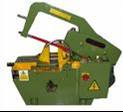Hello John, would that be one of the ones that is oriented vertically, the head will tilt 45 degrees either direction, the table and vises are fixed, the head advances into the material to be cut and the auto feed portion of the saw uses a sliding weight that is friction driven off of the saw drive to adjust cutting pressure? If that's the one, they are definitely a great piece of machinery, simplicity and functionality. I could see where it would be a great saw for cutting test pieces. I use a DoAll horizontal saw and have a few special fixtures that I use when I cut coupons. If I do an unlimited 3G and 4G, I will stack them face to face, tack them on the four corners, put a tack in the middle between the two plates at both ends and then saw 1" off of the end, advance the plates in the vise and saw a 3/8" plus slice off for the coupons, then I will flip it over and repeat the same procedure on the other end of the plates. Once I have the coupons cut, I will remove the small portion of backing strip that is left and sand them in preparation for bending. Prior to sawing I will stamp a row of v's across the end of the vertical plate so that I can readily identify the vertical coupons from the overhead. Regards, Allan

